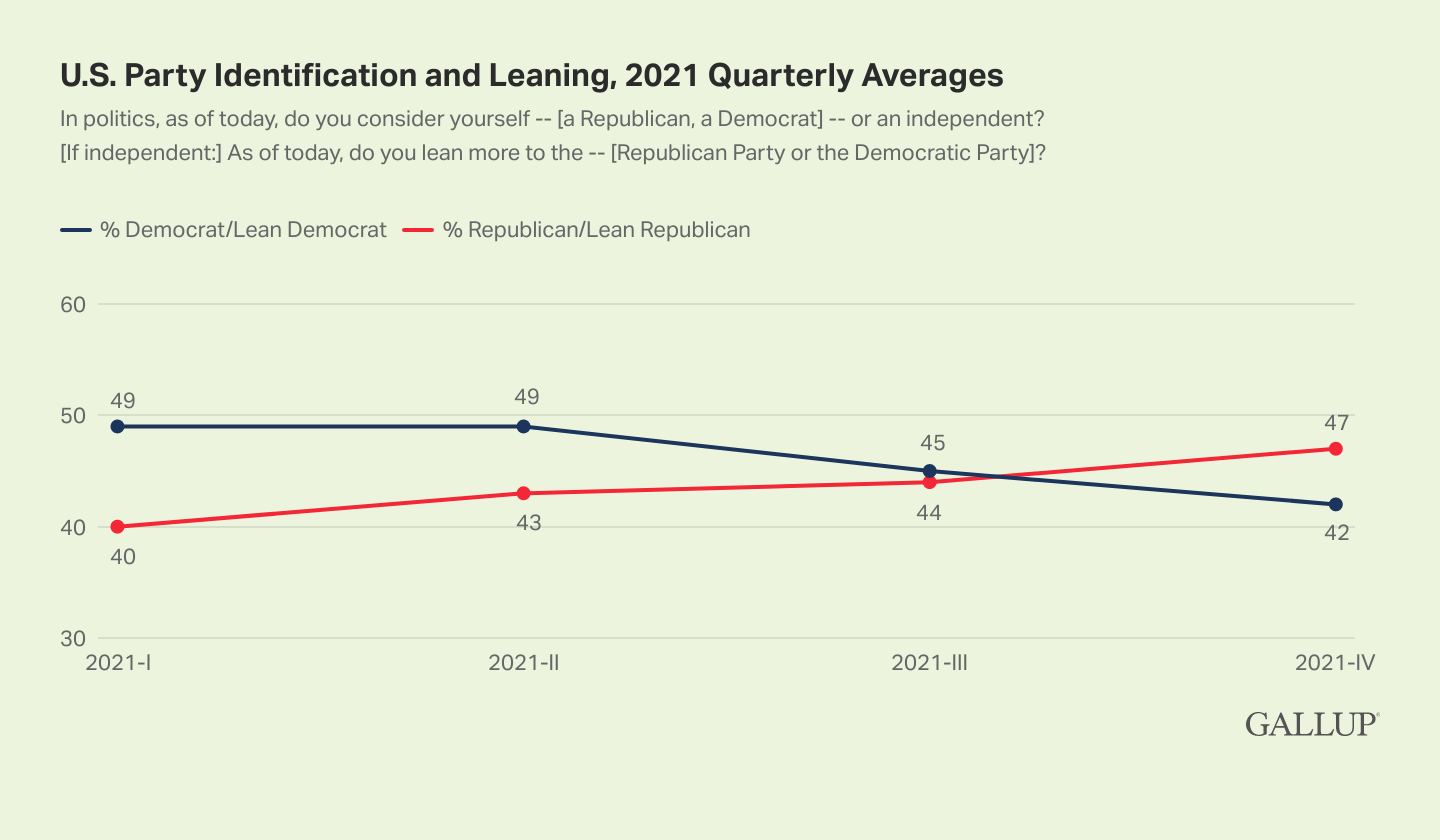In typical years, the Gallup polling organization finds that more voters tend to self-identify as Democrats than as Republicans. There have been rare times, when the electorate shifts dramatically, and the GOP picks up momentum. Usually, Dems carry the day with more registered and self-identified voters overall.
That trend, however, has shifted drastically in the last three months of 2021 when Republicans overtook Democrats by five points and now lead the trend line in voter identification:
On average, Americans’ political party preferences in 2021 looked similar to prior years, with slightly more U.S. adults identifying as Democrats or leaning Democratic (46%) than identified as Republicans or leaned Republican (43%).
However, the general stability for the full-year average obscures a dramatic shift over the course of 2021, from a nine-percentage-point Democratic advantage in the first quarter to a rare five-point Republican edge in the fourth quarter.
These results are based on aggregated data from all U.S. Gallup telephone surveys in 2021, which included interviews with more than 12,000 randomly sampled U.S. adults.
Gallup asks all Americans it interviews whether they identify politically as a Republican, a Democrat or an independent. Independents are then asked whether they lean more toward the Republican or Democratic Party. The combined percentage of party identifiers and leaners gives a measure of the relative strength of the two parties politically.
This isn’t too shocking, in a way, since President Biden continues to erode in terms of voter confidence and approval. He has several burning fires around him, from inflation to Covid, and a sense that the United States is on a weak footing internationally.
Here’s the full trend line from the start of 2021 to really encompass what’s changed:

Democrats have lost 7 points and Republicans have gained 7 points, a reversal of moderate-leaning voters undoubtedly who have soured on the Biden brand. What this portends for 2022 is a potential wipeout of Democratic majorities in the Hosue and Senate.
As Gallup explains further, Democrats held a historically high advantage in the first quarter of 2021, and Republicans hold a historically high advantage now:
Both the nine-point Democratic advantage in the first quarter and the five-point Republican edge in the fourth quarter are among the largest Gallup has measured for each party in any quarter since it began regularly measuring party identification and leaning in 1991.
To call the shift “dramatic” is almost an understatement. Seismic is a word that better grasps the change and the rapid departure voters are making from the Democratic Party.
For Republicans, a five-point advantage is monumental and has only happened a handful of times in modern political history:
The GOP has held as much as a five-point advantage in a total of only four quarters since 1991. The Republicans last held a five-point advantage in party identification and leaning in early 1995, after winning control of the House of Representatives for the first time since the 1950s. Republicans had a larger advantage only in the first quarter of 1991, after the U.S. victory in the Persian Gulf War led by then-President George H.W. Bush.
The momentum for the GOP can’t be undersold at this point and is driven mainly by Biden’s terrible handling of the country. America was sold a president who promised competent, calm, unifying leadership. Instead, Biden has turned into an incompetent president with awful advisors and is now devolving into a divisive political figure fighting with his own party in Congress.
Moderates within the Democratic Party see the trainwreck happening as the White House, for some inexplicable reason, tries to please the most liberal left-wing loons within the party at the expense of addressing issues voters care about. Biden has become a mouthpiece for the most extreme elements of his party and voters are now shopping elsewhere for better leadership.
No other president in the last 75 years has seen such a rapid first-year drop in support as Biden has experienced over the past 12 months. The Gallup party identification poll is catching up with voters who are ready to vote for something else.
Donate Now to Support Election Central
- Help defend independent journalism
- Directly support this website and our efforts
